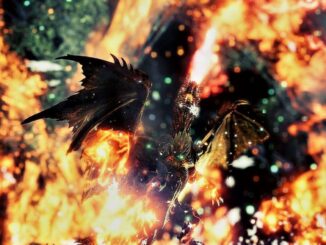
A collection of ultra-quick guides on what to do once you’ve engaged your target.
Guide Contents
Introduction
Note: Credit goes to SCPantera
This guide is an ultra-quick look at how to use your weapon in combat. No build discussion or weapon theory here, just the tl;dr “what do I do”.
This guide is hastily thrown together from a combination of personal experience and Arekkz Gaming’s weapon guide videos–which ended up being the simplest and best place to go to for me to find collected guides for every weapon in one place–and will be a work in progress until if/whenever I get around to putting time into every weapon. I’ve been playing with a variety of weapons and can comment on several, but even for the ones that I can’t I’ll include direct links to the “Best Combos” segments of each of Arekkz Gaming’s guides (sorry I couldn’t embed them in the guide itself–this was the only way I could get the time codes to carry through the link).
Note: The Arekkz guides I’m linking here are comprehensive weapon guides from vanilla and don’t include new mechanics introduced for each weapon in Iceborne, which are usually (but not always) newly integral to how the weapon plays. If no other information is available on how to use these new mechanics I recommend looking at the in-game Hunter’s Notes which will have a tab for the new Iceborne mechanics, so take a quick look at those after checking out Arekkz’s guides.
Terminology
I’m going to use some non-traditional references to buttons to accommodate all potential keybind layouts or controller setups, listed here:
[P]: For Primary attack, listed as “Normal Attack” in keybinds (ie the button that draws your weapon).
[S]: For Secondary attack, listed as “Special Attack”.
[Q]: For Unique attack.
↑ Denotes forward, ↓ Denotes backwards.
> Will be used to indicate button transitions for combos.
Greatsword
- True Charge Slash style is king right now; a couple other playstyles are still viable but if you’re not trying to do something ultra specific you should be aiming for TCS.
- True Charge Slash is the last attack in the three part ↑[P]>↑[P]>↑[P] combo.
- All charge attacks can be canceled into Tackle, after which the combo proceeds to the next step; this is how you can get to TCS the fastest and in many situations going directly to TCS is better damage over time than letting all 3 hits of the combo play out.
- Don’t be afraid to let TCS fire off without charging if your opening isn’t long enough.
- Charge attacks do less damage when overcharged (ie if you hold the charge until the attack activates on its own), for the most damage release after the final pulse (the visual indicator is a lot more “flamey” than the others).
- TCS does more damage if all the preceding hits in the combo were charged to full, but this is often too insane of a time sink to expect to use often.
Longsword
Sword and Shield
Dual Blades
- Everything about Dual Blades is situational but in general you want to be in Demon Mode when you can be relatively sure of your attack openings and in Archdemon Mode at all other times.
- Demon Dance is the target attack against a stationary target but you can get the most of it by ending the [P]>[P]>[P] combo with it; you can also add [S]>[S] to the start of that Primary combo to slide into position.
- Basic chain combo/infinite is chaining [P]>[P]>[P] into [S]>[S](>Extra [S] w/ Demon Mode) back and forth and starting from either.
Charge Blade
Switch Axe
Hammer
- Always, always, ALWAYS Power Charge up. If ya club ain’t red, yo target ain’t gon be ded.
- The best damage combo, viable only on immobilized targets, is a level 1 or 2 charge > [P]>[S]> repeating [S] into the big swing at the end.
- All levels and varieties of charge attacks are good for limited openings.
- If you’re not willing to run at least 1 level of Flinch Free in multiplayer you honestly might as well play another weapon instead.
Hunting Horn
- Hunting Horn is less complicated and very easy to pick up and play since generally your focus will be less on pouring out as much damage yourself as possible as on keeping your buffs up.
- The new-to-Iceborne fourth note is only usable following another attack but is pretty solid damage if you want to spam that for some numbers.
Lance
Gunlance
- For Gunlance your target combos will vary by shelling style and equipment; for this I’ll highlight some notes from this builds guide.
- Normal shelling is high-animation-commitment-high-reward and wants to be going for a slam > burst > sweep > reload combo at all times.
- Wide shelling is very flexible; you want to be alternating normal pokes and shelling for limited openings and set yourself up for the full slam combo on downed monsters.
- Long shelling is all about spammin’ that shellin’.
- The new-to-Iceborne Wyrmstake Blast is very important to maximizing your damage output. Every time shelling hits the implanted stake it explodes giving you a nice juicy chunk of extra damage and makes Long shelling competitive with the other two styles. The stake can be triggered by other GL users, so having multiple in one group can start to get pretty silly. Stake uptime can be increased by slinger capacity skills.
Insect Glaive
But here’s the tl;dr
- Insect buff up ASAP; red + white is mandatory and then either take orange immediately or use it to reset the buff timer.
- Iceborne added Kinsect Charging which you should definitely do in order to speed up reapplying insect buffs.
- Orange charge comes from slinger ammo found on the map (stones, brightmoss, etc.) and increases kinsect stamina and buff duration but lasts only a short while (however since you can just grab a stack of 20 stone at the start of a hunt you can just spam the charge whenever you have a second of downtime).
- Red charge comes from slinger ammo dropped from monsters (bomb pod, stinger, etc.) and increases kinsect damage and dust spreading frequency and also lasts for a long while.
- Some glaives give a bonus charge, for example Infinite Wisdom gives red charge WITH orange charge.
- For limited openings your goal is to Tornado Slash as often as possible.
- For longer openings the [P]>[P]>[S]>etc. infinite combo is the higher sustained damage by a small amount compared to the [S]>[S]>[P]>etc. infinite. The former doesn’t have to be as frequently repositioned but the latter includes Tornado Slash.





Be the first to comment